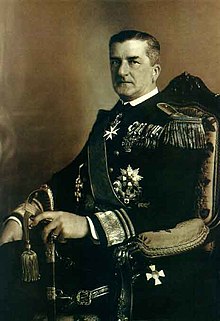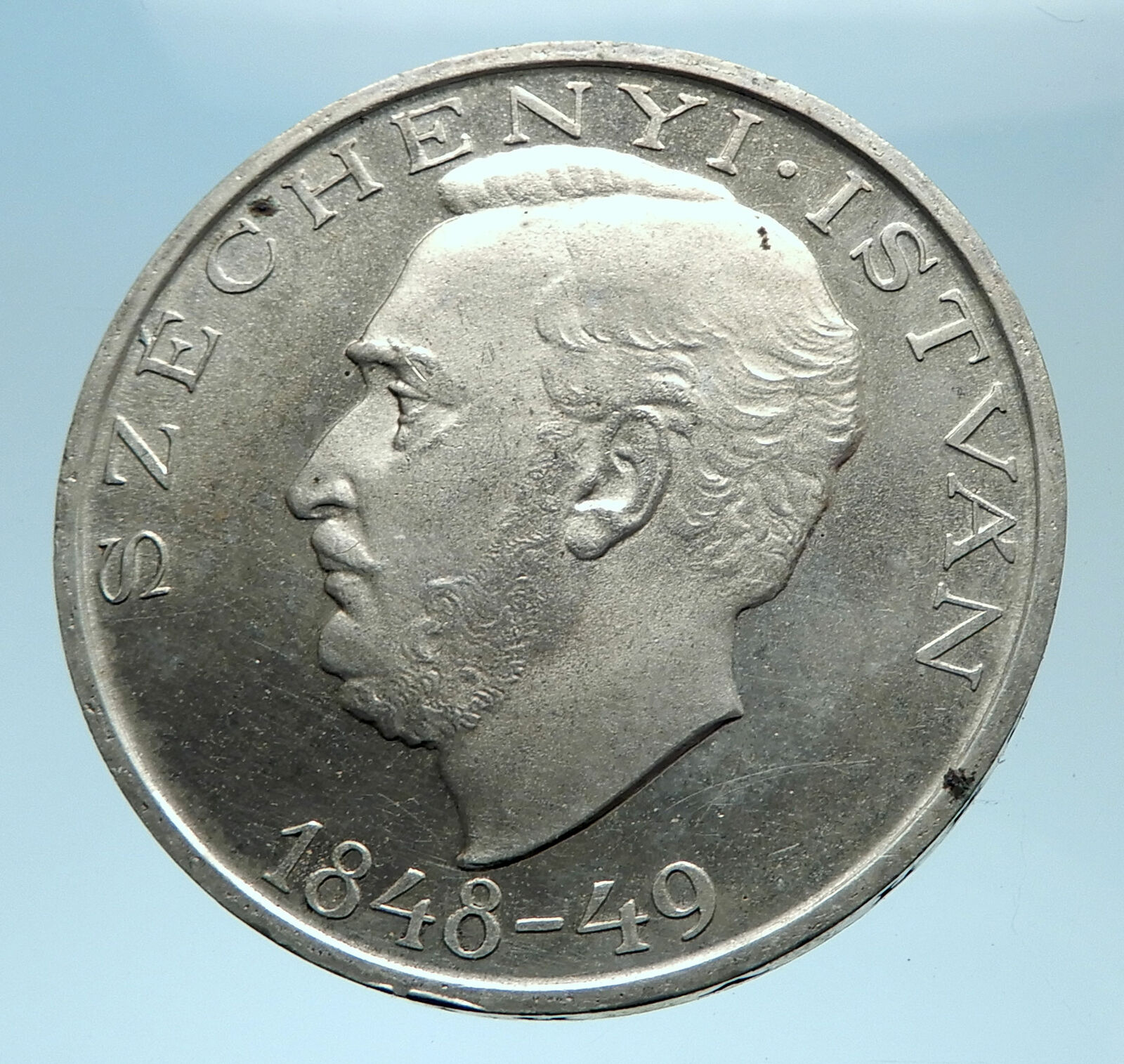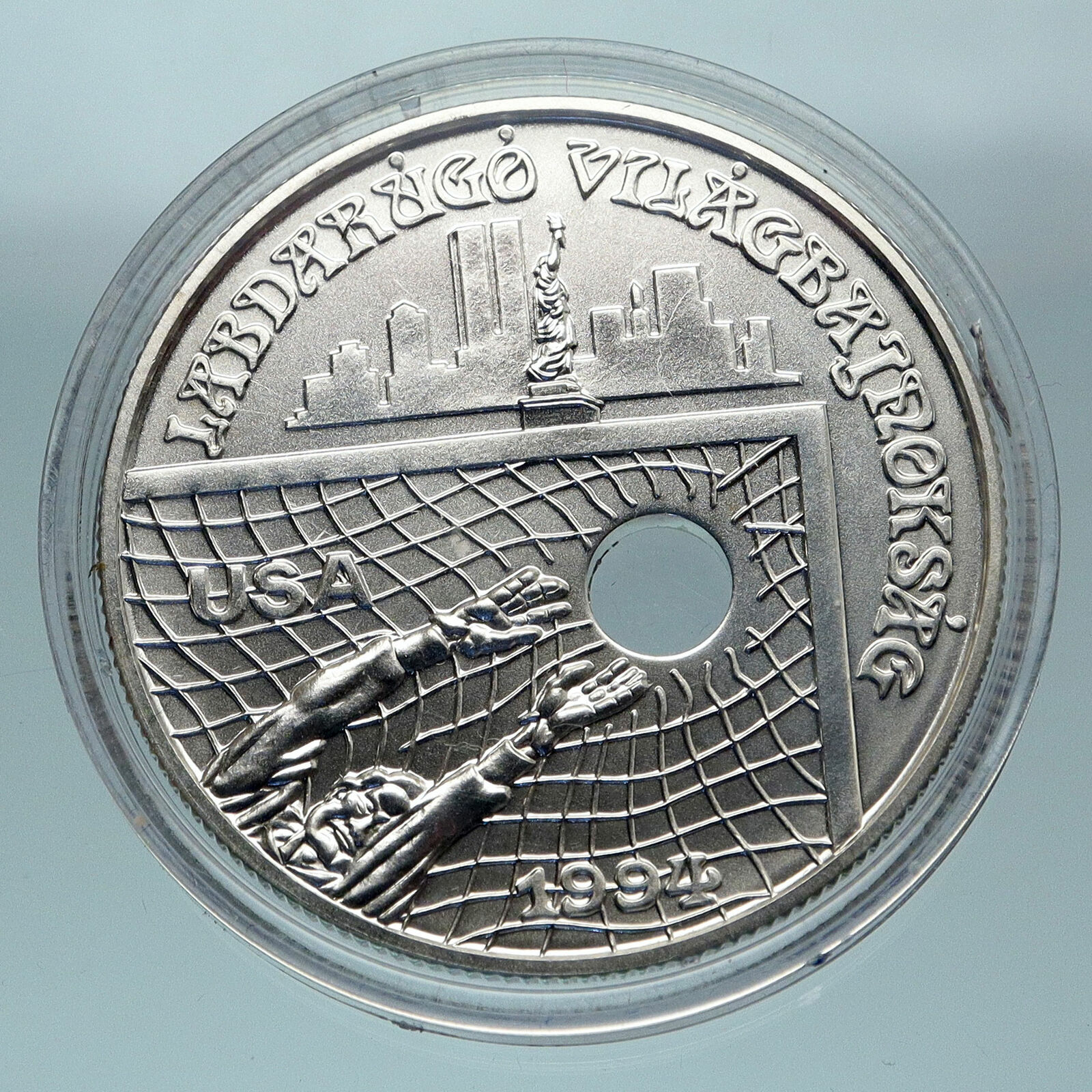|
Hungary – Admiral Miklos Horthy Commemorative
1939 Silver 5 Pengő 36mm (24.90 grams) 0.640 Silver (0.5144 oz. ASW)
Reference: KM# 517
Certification: NGC
AU DETAILS 2863704-011
MAGYAR KIRÁLYSÁG 19 39 5 PENGŐ BP, Crowned shield with standing angel supporters. ·VITÉZ·NAGYBÁNYAI·HORTHY·MIKLÓS· MAGYARORSZÁG·KORMÁNYZÓJA·, Uniformed bust left.
You are bidding on the exact item pictured, provided with a Certificate of Authenticity and Lifetime Guarantee of Authenticity.
 Miklós Horthy de Nagybánya (Hungarian: Vitéz nagybányai Horthy Miklós; English: Nicholas Horthy; German: Nikolaus Horthy Ritter von Nagybánya; 18 June 1868 – 9 February 1957) was a Hungarian admiral and statesman, who became the Regent of Hungary. He served as Regent of the Kingdom of Hungary between World Wars I and II and throughout most of World War II, from 1 March 1920 to 15 October 1944. He was styled “His Serene Highness the Regent of the Kingdom of Hungary” (Hungarian: Ő Főméltósága a Magyar Királyság Kormányzója). Miklós Horthy de Nagybánya (Hungarian: Vitéz nagybányai Horthy Miklós; English: Nicholas Horthy; German: Nikolaus Horthy Ritter von Nagybánya; 18 June 1868 – 9 February 1957) was a Hungarian admiral and statesman, who became the Regent of Hungary. He served as Regent of the Kingdom of Hungary between World Wars I and II and throughout most of World War II, from 1 March 1920 to 15 October 1944. He was styled “His Serene Highness the Regent of the Kingdom of Hungary” (Hungarian: Ő Főméltósága a Magyar Királyság Kormányzója).
Horthy started his career as a Sub-Lieutenant in the Austro-Hungarian Navy in 1896 and attained the rank of Rear-Admiral in 1918. He saw action in the Battle of the Strait of Otranto and became Commander-in-Chief of the Austro-Hungarian Navy in the last year of the First World War, he was promoted to Vice-Admiral and Commander of the Fleet when the previous Admiral was dismissed from his post by Emperor Karl following mutinies. In 1919, following a series of revolutions and external interventions in Hungary from Romania, Czechoslovakia, and Yugoslavia, Horthy returned to Budapest with the National Army and was subsequently invited to become Regent of the Kingdom by parliament. Horthy led a national conservative government through the interwar period, banning the Hungarian Communist Party as well as the Arrow Cross Party, and pursuing an irredentist foreign policy in the face of the Treaty of Trianon. King Charles IV unsuccessfully attempted twice to return to Hungary until, in 1921, the Hungarian Government caved in to Allied threats to renew hostilities. King Charles was escorted out of Hungary on a British warship into exile.
In the late 1930s, Horthy’s foreign policy led him into a reluctant alliance with Germany against Soviet Russia. With the begrudging support of Adolf Hitler, Horthy was able to recover certain Hungarian lands removed from them by the Allies. Under Horthy’s leadership, Hungary gave support to Polish refugees in 1939 and participated in a supportive (as opposed to front-line) role in the German invasion of the Soviet Union in 1941 and during the German invasion of Yugoslavia the same year occupied and annexed former Hungarian territories which had been given to the Kingdom of Serbs, Croats and Slovenes (from 1929 Yugoslavia) by the Allies after the First World War. However, Horthy’s reluctance to contribute to the German war effort and the Holocaust in Hungary, as well as refusing to hand over more than 600,000 of the 825,000 Hungarian Jews to German authorities, coupled with several attempts to strike a secret deal with the Allies of World War II after it had become obvious that Axis would lose the war, eventually led the Germans to invade and take control of the country in March 1944 in Operation Margarethe. In October 1944, Horthy announced that Hungary had declared an armistice with the Allies and withdrawn from the Axis. He was forced to resign, placed under arrest by the Germans and taken to Bavaria. At the end of the war, he came under the custody of American troops.
After appearing as a witness at the Nuremberg war-crimes trials in 1948, Horthy settled and lived out his remaining years in exile in Portugal. His memoirs, Ein Leben für Ungarn (A Life for Hungary), were first published in 1953. He is perceived as a controversial historical figure in contemporary Hungary.

 Hungary is a sovereign state in Europe. It is situated in the Carpathian Basin and is bordered by Slovakia to the north, Romania to the east, Serbia to the south, Croatia to the southwest, Slovenia to the west, Austria to the northwest, and Ukraine to the northeast. The country’s capital and largest city is Budapest. Hungary is a member of the European Union, NATO, the OECD, the Visegrád Group, and the Schengen Area. The official language is Hungarian, which is the most widely spoken non-Indo-European language in Europe. Hungary is a sovereign state in Europe. It is situated in the Carpathian Basin and is bordered by Slovakia to the north, Romania to the east, Serbia to the south, Croatia to the southwest, Slovenia to the west, Austria to the northwest, and Ukraine to the northeast. The country’s capital and largest city is Budapest. Hungary is a member of the European Union, NATO, the OECD, the Visegrád Group, and the Schengen Area. The official language is Hungarian, which is the most widely spoken non-Indo-European language in Europe.
 Following centuries of successive habitation by Celts, Romans, Huns, Slavs, Gepids, and Avars, the foundation of Hungary was laid in the late 9th century by the Hungarian grand prince Árpád in the Honfoglalás (“homeland-conquest”). His great-grandson Stephen I ascended to the throne in 1000 CE, converting the country to a Christian kingdom. By the 12th century, Hungary became a middle power within the Western world, reaching a golden age by the 15th century. Following the Battle of Mohács in 1526 and about 150 years of partial Ottoman occupation (1541-1699), Hungary came under Habsburg rule, and later formed a significant part of the Austro-Hungarian Empire (1867-1918). Following centuries of successive habitation by Celts, Romans, Huns, Slavs, Gepids, and Avars, the foundation of Hungary was laid in the late 9th century by the Hungarian grand prince Árpád in the Honfoglalás (“homeland-conquest”). His great-grandson Stephen I ascended to the throne in 1000 CE, converting the country to a Christian kingdom. By the 12th century, Hungary became a middle power within the Western world, reaching a golden age by the 15th century. Following the Battle of Mohács in 1526 and about 150 years of partial Ottoman occupation (1541-1699), Hungary came under Habsburg rule, and later formed a significant part of the Austro-Hungarian Empire (1867-1918).
Hungary’s current borders were first established by the Treaty of Trianon (1920) after World War I, when the country lost 71% of its territory, 58% of its population, and 32% of ethnic Hungarians. Following the interwar period, Hungary joined the Axis Powers in World War II, suffering significant damage and casualties. Hungary came under the influence of the Soviet Union, which contributed to the establishment of a four-decade-long communist dictatorship (1947-1989). The country gained widespread international attention regarding the Revolution of 1956 and the seminal opening of its previously-restricted border with Austria in 1989, which accelerated the collapse of the Eastern Bloc.
On 23 October 1989, Hungary again became a democratic parliamentary republic, and today has a high-income economy with a very high Human Development Index. Hungary is a popular tourist destination attracting 10.675 million tourists a year (2013). It is home to the largest thermal water cave system and the second-largest thermal lake in the world (Lake Hévíz), the largest lake in Central Europe (Lake Balaton), and the largest natural grasslands in Europe (the Hortobágy National Park).
|









 Miklós Horthy de Nagybánya (Hungarian: Vitéz nagybányai Horthy Miklós; English: Nicholas Horthy; German: Nikolaus Horthy Ritter von Nagybánya; 18 June 1868 – 9 February 1957) was a Hungarian admiral and statesman, who became the Regent of Hungary. He served as Regent of the Kingdom of Hungary between World Wars I and II and throughout most of World War II, from 1 March 1920 to 15 October 1944. He was styled “His Serene Highness the Regent of the Kingdom of Hungary” (Hungarian: Ő Főméltósága a Magyar Királyság Kormányzója).
Miklós Horthy de Nagybánya (Hungarian: Vitéz nagybányai Horthy Miklós; English: Nicholas Horthy; German: Nikolaus Horthy Ritter von Nagybánya; 18 June 1868 – 9 February 1957) was a Hungarian admiral and statesman, who became the Regent of Hungary. He served as Regent of the Kingdom of Hungary between World Wars I and II and throughout most of World War II, from 1 March 1920 to 15 October 1944. He was styled “His Serene Highness the Regent of the Kingdom of Hungary” (Hungarian: Ő Főméltósága a Magyar Királyság Kormányzója). 
 Hungary is a sovereign state in Europe. It is situated in the Carpathian Basin and is bordered by Slovakia to the north, Romania to the east, Serbia to the south, Croatia to the southwest, Slovenia to the west, Austria to the northwest, and Ukraine to the northeast. The country’s capital and largest city is Budapest. Hungary is a member of the European Union, NATO, the OECD, the Visegrád Group, and the Schengen Area. The official language is Hungarian, which is the most widely spoken non-Indo-European language in Europe.
Hungary is a sovereign state in Europe. It is situated in the Carpathian Basin and is bordered by Slovakia to the north, Romania to the east, Serbia to the south, Croatia to the southwest, Slovenia to the west, Austria to the northwest, and Ukraine to the northeast. The country’s capital and largest city is Budapest. Hungary is a member of the European Union, NATO, the OECD, the Visegrád Group, and the Schengen Area. The official language is Hungarian, which is the most widely spoken non-Indo-European language in Europe. Following centuries of successive habitation by Celts, Romans, Huns, Slavs, Gepids, and Avars, the foundation of Hungary was laid in the late 9th century by the Hungarian grand prince Árpád in the Honfoglalás (“homeland-conquest”). His great-grandson Stephen I ascended to the throne in 1000 CE, converting the country to a Christian kingdom. By the 12th century, Hungary became a middle power within the Western world, reaching a golden age by the 15th century. Following the Battle of Mohács in 1526 and about 150 years of partial Ottoman occupation (1541-1699), Hungary came under Habsburg rule, and later formed a significant part of the Austro-Hungarian Empire (1867-1918).
Following centuries of successive habitation by Celts, Romans, Huns, Slavs, Gepids, and Avars, the foundation of Hungary was laid in the late 9th century by the Hungarian grand prince Árpád in the Honfoglalás (“homeland-conquest”). His great-grandson Stephen I ascended to the throne in 1000 CE, converting the country to a Christian kingdom. By the 12th century, Hungary became a middle power within the Western world, reaching a golden age by the 15th century. Following the Battle of Mohács in 1526 and about 150 years of partial Ottoman occupation (1541-1699), Hungary came under Habsburg rule, and later formed a significant part of the Austro-Hungarian Empire (1867-1918).




